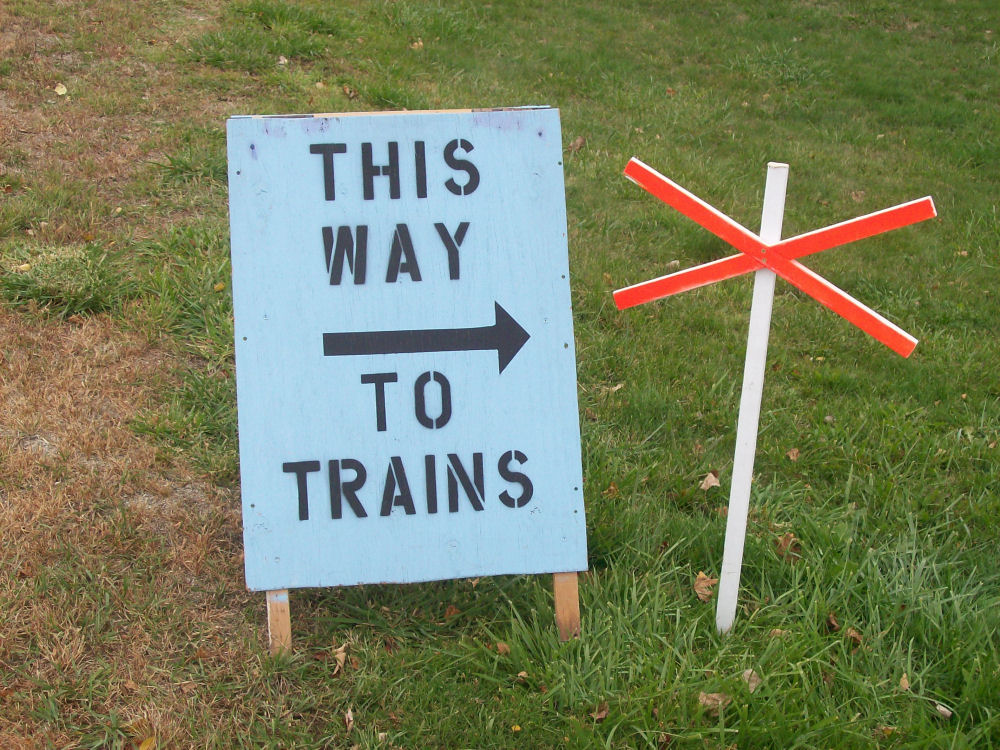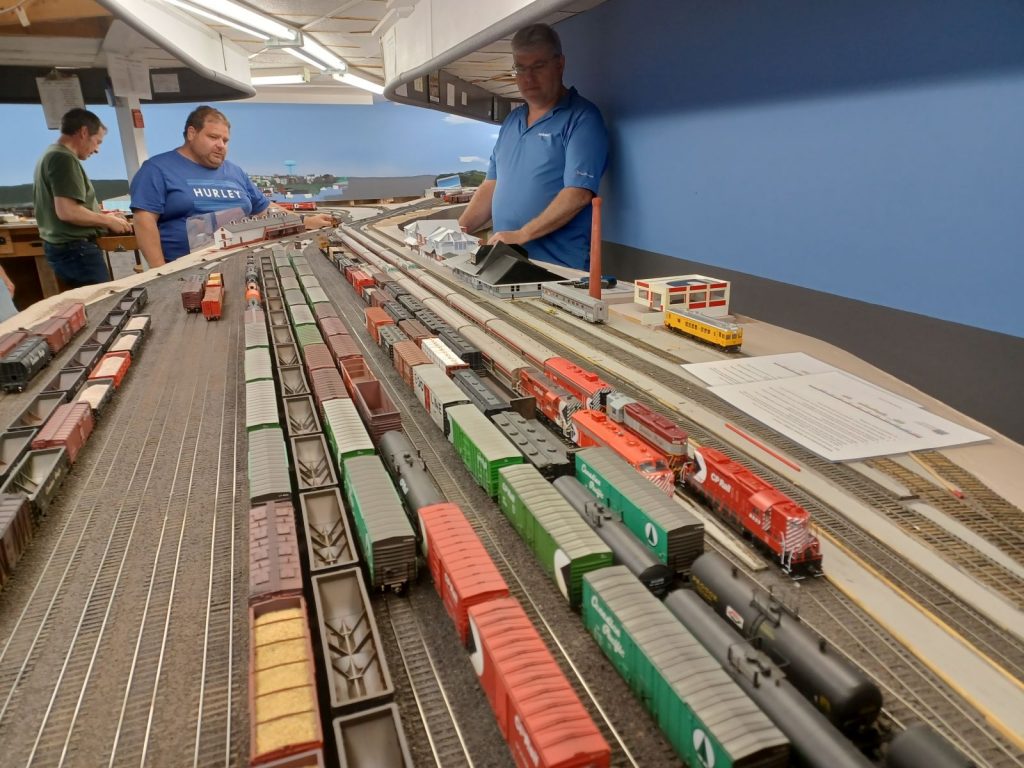DEFINITIONS
Note – for the purposes of these rules, the following definitions apply.
- Approach Signal
- A fixed signal used in connection with one or more signals to govern the approach thereto.
- Automatic Block Signal System (ABS)
- A series of consecutive blocks governed by block signals, cab signals, or both, actuated by a train or engine, or by certain conditions affecting the use of the block.
- Block
- A length of track of defined limits, the use of which by trains or engines is governed block signals, cab signals, or both.
- Block Indicator
- A device located at hand operated or spring switches to indicate track occupancy in the block or blocks to which it refers.
- Block Signal
- A fixed signal at the entrance of a block to govern trains and engines entering and using the block.
- Cab Signal
- A signal located in engineman’s compartment or cab, indicating a condition affecting the movement of a train or engine and used in conjunction with interlocking or block signals, or in lieu of block signals.
- Centralized Traffic Control (CTC)
- A system in ABS territory under which train or engine movements are authorized by block signals whose indications supersede the superiority of trains for both opposing and following movements on the same track.
- Current of Traffic
- The movement of trains on a main track in one direction specified by the rules.
- Division (or Area)
- That portion of a railway assigned to the superivision of a Superintendent or other designated officer.
- Dual Control Switch
- A power operated switch also equipped for hand operation.
- Dwarf Signal
- A low signal used as a block or interlocking signal.
- Electric Switch Lock
- An electric lock connected with a hand operated switch to prevent its operation until the lock is released.
- Engine
- A unit propelled by any form of energy, or a combination of such units operated from a single control, used in train or yard service.
- Engineman
- The employee in charge of and responsible for the operation of an engine.
- Extra Train
- A train not authorized by a time table schedule.
- Fixed Signal
- A signal of fixed location indicating a condition affecting the movement of a train or engine.
- Grade Signal
- A stop and proceed signal equipped with a marker displaying the letter “G”.
- Initial Station
- The station at which a schedule is first timed on any subdivision is the initial station for that schedule, and for an extra train it is the station at which the train is created.
- Interlocking
- An arrangement of signals and signal appliances so interconnected that their movements must succeed each other in proper sequence and for which interlocking rules are in effect. It may be operated manually or automatically.
- Interlocking Limits
- The tracks between the extreme or outer opposing interlocking signals of an interlocking.
- Interlocking Signal
- A fixed signal at the entrance to or within interlocking limits to govern the use of the routes.
- Main Track
- A track extending through yards and between stations, upon which trains are operated by time table or train order, or both, or the use of which is governed by block signals, interlocking signals, or other method of control.
- Pilot
- An employee assigned to a train when the engineman or conductor, or both, are not fully acquainted with the physical characteristics or rules of the railway, or portion of the railway, over which the train is to be moved.
- Register Station
- A station at which a train register is located.
- Regular Train
- A train authorized by a time table schedule.
- Route
- The tracks a train or engine may use in passing from one point to another.
- Schedule
- That portion of a time table which prescribes class, direction, number and movement for a regular train.
- Section
- One of two or more trains running on the same time table schedule displaying signals or for which signals are displayed.
- Siding
- A track auxiliary to the main track for meeting or passing trains. Sidings and their capacities will be designated in the time table or special instructions.
- Signal Indication
- The information conveyed by a fixed signal or cab signal.
- Speeds
- RESTRICTED SPEED – A speed that will permit stopping within one half the range of visions. Where ABS rules, interlocking rules or signal indications require movement at restricted speed, such movement must be made at a speed that will permit stopping within one-half the range of vision, also prepared to stop short of switch not properly lined, and to be on the lookout for broken rail, and in no case exceeding SLOW speed.
SLOW SPEED – A speed not exceeding fifteen miles per hour.
MEDIUM SPEED – A speed not exceeding thirty mile per hour.
LIMITED SPEED – A speed not exceeding forty five miles per hour. - Spring Switch
- A switch equipped with a spring mechanism arranged to restore the switch points to normal position after having been trailed through.
- Station Protection Signal
- A stop and proceed signal equipped with a marker displaying the letters “SPS”, used to protect trains or engines occupying the main track in yards or at stations in the block protected by the signal.
- Station
- A place designated in the time table by name.
- Subdivision
- A portion of a division or area designated by time table.
- Superior Train
- A train train having precedence over another train.
- Terminating Station
- The station at which a schedule is last timed on any subdivision is the terminating station for that schedule, and for an extra train (except work extras) it is the station to which such train is authorized.
- Time table
- The authority for movement or regular trains subject to the rules. It contains classified schedules, also special instructions relating to the movement of trains and engines.
- Train
- An engine or more than one engine coupled, with or without cars, displaying markers.
- Train of Superior Right
- A train given precedence by train order.
- Train of Superior Class
- A train given precedence by time table.
- Train of Superior Direction
- A train given precedence in the direction specified by time table as between opposing trains of the same class.
- Train Order Signal
- A fixed signal provided at train order offices used in connection with the delivery of train orders and as prescribed by Rule 91A.
- Train Register
- A book or form used at designated stations for registering signals displayed, the time of arrival and departure of trains and such other information as may be prescribed.
- Two Or More Tracks
- Two or more main tracks upon any of which the current of traffic may be in either specified direction.
NOTE: Where two main tracks are in service, each of which is signalled for traffic in both directions, these tracks will be designated as “North Track” and “South Track” where time table directions are Eastward and Westward, respectively, and “East Track” and “West Track” where time table direction are Northward and Southward, respectively. Where tracks are so designated, there is no specified current of traffic. - Yard
- A system of tracks provided for the making up of trains, storing of cars and for other purposes, over which movements not authorized by time table or train order may be made, subject to prescribed signals, rules and special instructions.
- Yard Engine
- An engine assigned to yard service.
- Yard Limits
- That portion of the main track or main tracks within limits defined by yard limit signs.


